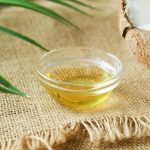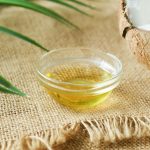You can easily make a natural fabric softener using coconut oil, white vinegar, baking soda, essential oils, and water. Start by melting 1/4 cup of coconut oil, then whisk it into 2 cups of water. Add 1/2 cup of vinegar, baking soda for odor removal, and essential oils for fragrance. Store it in a sealed container and shake before each use to soften clothes naturally without harsh chemicals. Keep going to discover tips and tricks for the best results.
Table of Contents
Key Takeaways
- Melt 1/4 cup coconut oil and whisk into 2 cups water for a smooth base fabric softener mixture.
- Add 1/4 cup white vinegar and 10-15 drops essential oils for softness, odor removal, and fragrance.
- Use a clean airtight container to store the mixture and shake well before each use to prevent oil separation.
- Avoid overuse to prevent greasy residue and never apply the softener directly to delicate fabrics.
- Enjoy eco-friendly, chemical-free softness that saves money and reduces environmental impact compared to commercial softeners.
Benefits of Using Coconut Oil as Fabric Softener
Although you might be used to commercial fabric softeners, using coconut oil offers a natural alternative that softens your clothes without harsh chemicals.
You’ll find your fabrics feel smoother and more comfortable against your skin. Coconut oil naturally moisturizes fibers, reducing stiffness and static cling. It also helps preserve the life of your garments by preventing wear and tear caused by synthetic softeners.
Plus, you’ll appreciate that coconut oil is biodegradable and eco-friendly, making it a great choice for the environment.
Coconut oil is biodegradable and eco-friendly, offering a natural, planet-friendly alternative for your laundry routine.
When you switch to coconut oil, you’re not just softening clothes—you’re choosing a safer, sustainable option that’s gentle on your family and the planet.
It’s an easy way to care for your laundry while supporting greener living.
Essential Ingredients for DIY Coconut Oil Fabric Softener
Using coconut oil as a fabric softener is a smart choice, but getting the best results means combining it with the right ingredients. To guarantee softness, freshness, and easy application, you’ll need a few essentials that work synergistically with coconut oil. Here’s a quick guide:
| Ingredient | Purpose | Suggested Amount |
|---|---|---|
| Coconut oil | Softening agent | 1/4 cup |
| White vinegar | Removes residue, softens | 1/2 cup |
| Baking soda | Neutralizes odors | 1 tablespoon |
| Essential oils | Adds fragrance | 10-15 drops |
| Water | Dilutes mixture, easy use | 2 cups |
Mix these carefully, and you’ll have a natural fabric softener that’s effective and gentle on clothes.
Tools Needed to Prepare the Softener
To prepare your DIY coconut oil fabric softener efficiently, you’ll need a handful of essential tools that make mixing and storing the solution simple.
Start with a medium-sized mixing bowl to combine your ingredients comfortably. A whisk or sturdy spoon will help you blend the coconut oil thoroughly, ensuring a smooth texture.
Measuring cups and spoons are vital for accuracy, so your recipe turns out just right. For storage, grab a clean, airtight container—preferably glass or BPA-free plastic—to keep your softener fresh and easy to use.
You might also want a funnel to transfer the mixture without spills. Having these tools ready before you start will save you time and keep the process neat and straightforward.
Step-by-Step Guide to Making Coconut Oil Fabric Softener
With your tools ready, you can move on to making the coconut oil fabric softener. Start by melting 1/4 cup of coconut oil in a double boiler until fully liquid.
Next, pour 2 cups of distilled water into a large mixing bowl. Slowly add the melted coconut oil to the water while whisking vigorously to help them combine.
Then, mix in 1/4 cup of white vinegar, which acts as a natural softening agent. For a pleasant scent, add 10-15 drops of your favorite essential oil and stir well.
Transfer the mixture into a clean, airtight container or bottle. Shake well before each use, as the oil and water may separate over time.
Your natural coconut oil fabric softener is now ready!
How to Use Coconut Oil Fabric Softener in Laundry
A natural fabric softener like the coconut oil mixture can easily fit into your laundry routine.
When you’re ready to wash, add about 1/4 to 1/3 cup of the homemade softener to the fabric softener dispenser in your washing machine. If your machine doesn’t have a dispenser, pour it into the final rinse cycle to avoid residue on clothes.
Make sure the mixture is well shaken before each use to keep the ingredients blended. Use it with cold or warm water settings, as hot water may separate the oils.
Shake well before use and opt for cold or warm water to keep oils blended and effective.
This coconut oil softener will leave your clothes feeling soft and smelling fresh without harsh chemicals, making your laundry experience gentler on your skin and the environment.
Tips for Storing Your Homemade Fabric Softener
Keeping your homemade coconut oil fabric softener fresh and effective depends largely on how you store it.
Use a clean, airtight container to prevent contamination and moisture from spoiling your mixture. Glass jars or sturdy plastic bottles with tight lids work best.
Store the softener in a cool, dark place like a cupboard or pantry to avoid heat and sunlight, which can break down the oils and reduce its effectiveness.
If your recipe contains water, give the bottle a good shake before each use to remix any separated ingredients.
Label your container with the date you made it, so you know when to make a fresh batch.
Following these storage tips will help your DIY fabric softener stay potent and ready for laundry day.
Common Mistakes to Avoid When Using Coconut Oil Softener
You’ll want to avoid overusing coconut oil softener, as it can leave a greasy residue on your clothes.
Make sure to mix it well with an emulsifier to keep it from separating.
Also, be cautious when applying it to delicate fabrics, since it might cause damage or stains.
Overuse Leading to Residue
Although coconut oil works wonders as a natural fabric softener, overusing it can leave your clothes feeling greasy and coated with residue.
When you add too much coconut oil, it doesn’t fully rinse out during the wash, causing buildup on fabric fibers. This residue attracts dirt, making your clothes look dingy and reducing their breathability.
To avoid this, use only a small amount—usually one to two teaspoons per load is enough. Spread it evenly or dilute it to guarantee it distributes properly.
If you notice any oily spots after washing, cut back on the amount next time. Remember, a little goes a long way; using too much defeats the purpose and leaves your laundry less fresh, not softer.
Mixing Without Emulsifier
When you mix coconut oil fabric softener without an emulsifier, the oil tends to separate and cling unevenly to your clothes. This separation can cause greasy spots or inconsistent softening effects. To avoid this, you need to properly blend the ingredients to create a stable mixture. Otherwise, you risk wasting your effort and ending up with fabric that feels sticky or oily in places.
| Mistake | Effect on Clothes |
|---|---|
| No emulsifier | Oil separates, uneven softening |
| Insufficient mixing | Clumps of oil, patchy softness |
| Using solid coconut oil | Hard to blend, uneven coating |
| Adding too much oil | Sticky residue, greasy feel |
| Skipping warm water | Poor oil dispersion |
Keep these points in mind to get smooth, evenly softened laundry every time.
Applying on Delicate Fabrics
Because delicate fabrics require gentle care, applying coconut oil fabric softener demands extra attention to avoid damage.
Don’t apply the softener directly onto your delicate clothes; the concentrated oil can leave stains or make the fabric greasy. Instead, dilute the coconut oil mixture thoroughly with water before use.
Avoid using hot water during rinsing, as it can cause coconut oil to solidify and cling to fibers. Always do a patch test on a small, hidden area before treating the entire garment.
Steer clear of overuse—too much softener can weigh down delicate fabrics and reduce breathability.
Finally, gently hand wash or use a delicate cycle to preserve the fabric’s integrity. These steps help you keep your delicate clothes soft without risking damage.
Comparing DIY Coconut Oil Softener With Commercial Products
When you compare DIY coconut oil softener to commercial products, you’ll notice significant savings on cost.
You’ll also reduce your environmental impact by avoiding harsh chemicals and excess packaging.
Let’s explore how making your own softener benefits both your wallet and the planet.
Cost Effectiveness
Although commercial fabric softeners offer convenience, making your own coconut oil softener can save you a significant amount of money over time.
When you mix your own, you control the ingredients and avoid the added costs of packaging and branding. Here’s why it’s cost effective:
- Bulk Buying: You can buy coconut oil and other ingredients in bulk, reducing the cost per use.
- Multi-Purpose Use: Coconut oil serves multiple household needs, so your investment stretches beyond just fabric softening.
- Reduced Frequency: Homemade softeners often require less product per load, making each batch last longer.
Environmental Impact
If you care about reducing your household’s ecological footprint, switching to a DIY coconut oil fabric softener can make a noticeable difference. Unlike commercial softeners, which often contain synthetic chemicals and plastic packaging, DIY versions use natural ingredients and minimal waste. This choice lowers pollution and reduces reliance on non-renewable resources.
| Aspect | DIY Coconut Oil Softener |
|---|---|
| Ingredients | Natural, biodegradable |
| Packaging | Reusable or minimal waste |
| Chemical runoff | Low impact on waterways |
| Carbon footprint | Reduced due to local sourcing |
| Energy use (production) | Minimal compared to industrial |
Additional Natural Additives to Enhance Your Fabric Softener
To boost your DIY coconut oil fabric softener, you can easily add natural ingredients that enhance its scent, softness, and antibacterial properties. These additives not only improve performance but also keep your laundry fresh and healthy. Here are three effective options:
Enhance your DIY coconut oil softener with natural additives for better scent, softness, and antibacterial power.
- Essential Oils – Add 10-15 drops of lavender, eucalyptus, or lemon oil for a pleasant aroma and extra antibacterial benefits.
- White Vinegar – Mix in 1/4 cup to soften fabrics naturally and help remove detergent residue without harsh chemicals.
- Baking Soda – Incorporate 2 tablespoons to balance pH levels, boost softness, and neutralize odors.
Frequently Asked Questions
Can Coconut Oil Fabric Softener Cause Allergies or Skin Irritation?
Yes, coconut oil fabric softener can cause allergies or skin irritation if you’re sensitive or allergic to coconut oil. Always test a small fabric area first and monitor your skin’s reaction to avoid any discomfort.
Is Coconut Oil Fabric Softener Safe for All Types of Washing Machines?
You might think all washing machines handle coconut oil fabric softener the same, but they don’t. While it’s generally safe, high-efficiency machines need smaller amounts to avoid residue buildup. Always check your manual first!
How Environmentally Friendly Is Homemade Coconut Oil Fabric Softener?
You’ll find homemade coconut oil fabric softener quite environmentally friendly since it uses natural ingredients, reduces chemical runoff, and cuts down on plastic waste. Just remember to use it sparingly to avoid residue buildup in your machine.
Can Coconut Oil Fabric Softener Help Reduce Static Cling?
Yes, coconut oil fabric softener can help reduce static cling because it adds moisture and smoothness to your clothes, which prevents static buildup. You’ll notice less static and softer fabrics after using it regularly.
Does Coconut Oil Fabric Softener Leave a Scent on Clothes?
Like a refreshing change, coconut oil fabric softener usually leaves a subtle, natural scent on your clothes. You won’t overpower your laundry, but you’ll catch a gentle, pleasant fragrance every time you wear them.
- Recycling Nonwoven Fabrics: Is It Possible? - July 11, 2025
- Recycling Nonwoven Fabrics: Is It Possible? - July 11, 2025
- Recycling Nonwoven Fabrics: Is It Possible? - July 11, 2025







